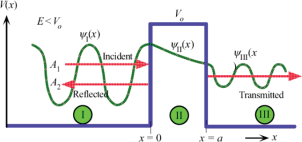MSE 351 Homework #2
Hello, dear friend, you can consult us at any time if you have any questions, add WeChat: daixieit
MSE 351 Homework #2
Due by 2:30pm on Thursday, January 25, 2024
1. Photoelectric effect. A photoelectric experiment indicates that violet light of wavelength 420 nm is the longest wavelength radiation that can cause photoemission of electrons from a particular multialkali photocathode surface.
a) What is the work function of the photocathode surface, in eV?
b) If UV radiation of wavelength 300 nm is incident upon the photocathode surface, what will be the maximum kinetic energy of the photoemitted electrons, in eV?
2. Schrödinger equation. Starting from the classical wave equation and de Broglie’s relationship, derive
the Schrödinger equation. (Hint: Total Energy = Kinetic Energy + Potential Energy)
3. Probability distribution. When V(x, t) = V(x), show that |Ψ(x, t)|2 = |ψ(x)|2 .
4. Energy dispersion of a free particle versus a particle in a box. The energy of a free particle and of a particle in a box are both described by the dispersion E = 2m/(hk)2 . Carefully sketch this E vs. k dispersion. For the case of the particle in a box, solving the TISE provides additional constraints on the allowed energies, as we derived in class. Denote these constraints graphically on your sketch.
5. Quantum dots. We can model a quantum dot as a particle in a one-dimensional box. Consider the special case in which fluorescent light is emitted by the quantum dot owing to the transition of an electron from the first excited state to the ground state. The wavelength of the emitted light is determined by the spacing of the allowed energy levels. If the size of the quantum dot is doubled, calculate the change in the wavelength of the emitted light.
6. Infinite and finite potential energy wells. First consider an infinite one dimensional potential energy (PE) well of width 1 nm. Calculate the energies of the first three levels. Then, consider a finite PE well with the same width (1 nm) and a barrier height of 2.0 eV. There are only three energy levels E1 = 0.23 eV, E2 = 0.89 eV, and E3 = 1.81 eV. Are the finite PE well levels higher or lower than the corresponding infinite well levels? Find the electron penetration depth into the barrier for each of the three energy levels. How does the penetration depth depend on the energy of the electron?
7. Tunneling. Consider the phenomenon of tunneling through a potential energy barrier of height V0and width a, as shown in the figure.
a) What is the probability that the electron will be reflected (i.e., find the reflection coefficient, R, given the transmission coefficient, T)? What happens to R as a, V0 , or both become very large?
b) For a wide barrier (aa ≫ 1), show that T0 can at most be 4, and that T0 = 4 when E = 2/1 V0 .

8. Electron impact excitation.
a) A projectile electron of kinetic energy 12.2 eV collides with a hydrogen atom in a gas discharge tube. Find the nth energy level to which the electron in the hydrogen atom gets excited.
b) Calculate the possible wavelengths of radiation (in nm) that will be emitted from the excited
H atom in part (a) as the electron returns to its ground state. Which one of these wavelengths will be in the visible spectrum?
2024-01-25